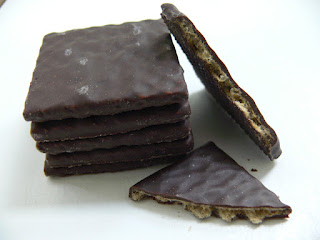 These days, chocolate-covered food products can be seen at every market, grocery store, pharmacy or health food store. And it seems that nearly everything can be covered in chocolate: almonds and other nuts are the most common, along with raisins and espresso beans, apricots, pretzels and all sort of other fruit and crunchy snacks. I have even eaten chocolate-covered kale. But chocolate-covered cacao beans? That is just plain rare.
These days, chocolate-covered food products can be seen at every market, grocery store, pharmacy or health food store. And it seems that nearly everything can be covered in chocolate: almonds and other nuts are the most common, along with raisins and espresso beans, apricots, pretzels and all sort of other fruit and crunchy snacks. I have even eaten chocolate-covered kale. But chocolate-covered cacao beans? That is just plain rare. However Camino, a Canadian brand of organic and Fair Trade chocolate products, has just launched a small line of 'treats', which includes Dark Chocolate-Covered Cacao Beans. Since I have only ever tried chocolate-covered cacao nibs, but never the whole bean covered in chocolate, I immediately ordered some.
Although these are called 'treats', it does not mean you should go crazy and give them as gifts to every chocoholic in your life. First know that your friends and family can handle the extra bitterness of this snack. The cacao beans are covered in a 70% dark chocolate and rolled in cocoa powder, so they are very bitter. But they have a nice crunch to them, so it is like eating a savoury, crunchy treat, like chips, rather than eating a sweet treat, like a Mars bar. So if your chocoholic friend is often seen eating a Hershey's milk chocolate bar, they probably will not like this snack. But if they are always buying 70% or higher dark chocolate, or are trying to reduce their sugar intake, they may be the perfect candidate.
What I like about these 'treats' compared to similar ones, is that cacao beans have minimal caffeine content compared to chocolate-covered coffee beans. And although coffee beans have no fat, the fat in cocoa beans is not unhealthy. Also, with so little sugar in this product and a huge boost of antioxidants, I do not feel guilt about tucking in for a chocolaty snack.
Camino brand can be found in health food stores and grocery stores across Canada. But you can also buy these online.
Looking for other chocolate covered cacao bean products? Through Google, I found an American brand, Kakawa Cocoa Beans, who make cacao beans that are covered in milk, white and dark chocolate (that's right, all three on one bean!). These look pretty tasty and probably a little sweeter than Camino's. Check them out at: http://www.cocoapuro.com/
Also, CRIO BRÜ sells chocolate covered Criollo cacao beans. And from what I can tell, they are not rolled in cocoa powder, which will create a slightly less bitter flavour experience. Check these out at:
I have a feeling that we will see more chocolate covered cacao bean products pop up at our local food retailers in the near future. It is a product that just makes sense to me. It is healthier than eating fully processed chocolate, it has less sugar content and provides both antioxidants and a boost of energy without over-caffeinating us.
As always, here are the full package details of the chocolate product that I tasted this week:
Camino Fair Trade/Organic Dark Chocolate-Covered Cacao Beans, 70% cacao, 100g
La-Siembra Co-Opertive (Ottawa, ON, Canada)
www.tasteofcamino.com
Organic Ingredients: whole cacao beans*, dark chocolate* (cacao mass*, cane sugar*, cacao butter*, cacao powder*).
*Fair Trade Certified.
Contains 100% Fair trade Certified ingredients by dry weight (info.fairtrade.net).
What is not on the package: The cacao beans and dark chocolate are single-origin sourced from Peru. The sugar in the chocolate comes from Paraguay.




+vs+Peru+(right).jpg)




.JPG)